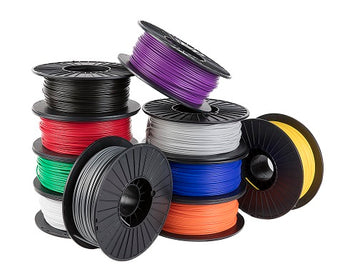From Pond to Printer.....3D Printing with Algae and Other Sustainable Materials

From Pond to Printer.....3D Printing with Algae and Other Sustainable Materials.

Here at Print Your Mind 3D, we are always interested in break through innovations in the 3D printing world around making the industry more sustainable. This is a large focus of our Enviromakers initiative and why we are funding research to aid with recycling waste material. We want to focus on what is already available on the market to aid in creating more sustainable 3D printing solutions. This has lead us to one of the industry leaders in sustainable material, Algix 3D.
We are excited to announce a new partnership with Algix 3D and welcomed a guest blog post you can find below. Also, the next 50 orders on our website will get a free 2.85mm 100 gram sample spool of their Algae filament. Please enjoy this guest blog post from Barbara Zeller of Algix 3D:
The topic of environmental sustainability transcends all industries. The global plastics problem and algal bloom problem continue to grow and get increasing media coverage as human populations expand and global temperatures rise. Every industry represented within the 3D printing space has its own set of environmental guidelines or regulations that it must follow.

Consumers are also becoming much more aware of their own personal environmental impacts and the potential hazards or concerns of the products that they bring into their homes, schools and workplaces. There are a growing variety of materials available for desktop fused filament fabrication (FFF)/ fused deposition modeling (FDM) 3D printing. Each of these materials has their own value proposition and benefits; but some of these benefits come at a cost.
Is it possible to have the material performances that you need, while also using materials that are safer for the users and the environment? Yes! You do not have to choose between these two important characteristics. There are materials available in the market that provide both benefits.

There are a few basics to understand when it comes to sustainable plastics. There is often a misconception that biobased, biodegradable and compostable plastics are one in the same.
- A few pertinent definitions:
- Biodegrade - breaks down into carbon dioxide, water and biomass.
- Disintegrate - the material is indistinguishable in compost, not visible or needing to be separated out.
- Eco-toxicity - the biodegradation does not produce any toxic material and the compost can support plant growth.
- Biobased plastics are made solely from organic biomass/ living organisms, such as plants, and not petroleum.
- Biodegradable plastics will break down, and can be made out of plant or petroleum based materials. These plastics will degrade over time from the action of naturally occurring microorganisms, such as bacteria. There is no requirement for what is left behind (eco-toxicity) or for the time taken to biodegrade.
- Compostable plastics will also break down, but using that term requires that a more stringent set of guidelines have been followed. Most international standards require biodegradation of 60% of the object within 180 days in order for the resin or product to be called compostable.
- When dealing with plastics that are more environmentally sustainable, you may come across some common certifications and terms, including: American Society for Testing and Materials (ASTM), European Standardization Committee (CEN), International Standards Organization (ISO) or the German Institute for Standardization (DIN).
Most people who have experience with 3D printing are familiar with the sustainable plastic material polylactic acid (PLA), which is often made from cornstarch or sugarcane, making it a biobased, biodegradable and compostable material. There are also filament materials available for 3D printing that are recycled, made from trash or other waste stream materials and even made from algae.
Want to learn more about 3D printing with sustainable filaments? Check out this Ultimaker blog post.

The world’s only algae filament is made by ALGIX 3D, which is a part of the ALGIX family of companies. At ALGIX they remediate and harvest nuisance algal blooms from all around the globe and make environmentally sustainable plastics with it……including the algae filament called ALGA. The algae is harvested from areas suffering from algal blooms, which are usually lakes or ponds used for aquaculture farming or polluted with too many nutrients because of a proximity to highly population dense areas or some kind of industry. The algae sludge is then dried to form an algae flake. The algae flake is powdered up and then compounded/ mixed in with whatever base plastic resin is needed for the end product. For 3D printing filaments, the powdered algae is blended with PLA to create the finished ALGA filament. Check out this video to learn more about ALGA:
ALGIX 3D is constantly developing and commercializing innovative, high performance and environmentally sustainable filaments for the FFF 3D printing market, with and without algae. You can learn more about their innovative materials by visiting their website at www.algix3d.com
Post by: Barbara Zeller, Marketing and Communications Manager, ALGIX 3D, www.algix3d.com







